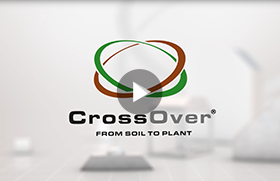Maximize your crop’s potential with CrossOver's soluble silicon
Your goal is to supply plants with nutrients and provide protection to optimize yield and quality. Standing between you and success are destructive outside elements, from heat and drought to metal and sodium toxicities.
Improvement in agricultural sustainability requires effective crop management and optimal use and management of soil fertility and soil physical properties. CrossOver is well-suited to manage both sides of the plant-soil equation.
Scientific evidence supporting silicon’s agronomic value to crops and soils is strong – and growing.
Following its application, CrossOver establishes a reservoir of water-soluble calcium, magnesium and monosilicic acid – the only form of silicon plants can use – providing unique benefits to the soil structure and the plant.
As silicon is absorbed by the plant, it crosses over from its involvement in geochemical reactions, becoming an active participant in numerous plant biological processes that enhance the crop’s ability to resist and tolerate environmental stresses and help regulate sodium and metal toxicities.
Stress defense
Just how sensitive are crops to environmental stresses? It is the most harmful factor impacting the growth and productivity of crops worldwide, accounting for yield reductions of up to 50 percent or more.
Studies clearly show that environmental stresses cause much higher crop losses than biotic stresses, including factors such as diseases and pests.
Plants may experience physiological stress when an environmental factor is excessive or deficient. Examples include the lack of water, certain nutrients or heat. These stressors are most harmful when they occur in combination.
Silicon’s biochemical properties enable it to interact with a host of enzymes, proteins and hormones and act as a modulator influencing the amplitude, timing and duration of stress transmission signals and protein-activated plant defense response pathways.
Many agricultural crops have an evolutionary predisposition for the uptake and use of silicon in tolerating stressful conditions and in quickening and enhancing recovery following stress.
Failing to provide silicon in ample supply produces a crop that is silicon-deficient and weakened, preventing it from attaining yield and crop quality expectations.
Phosphorous availability
It is especially important in environmentally sensitive areas to reduce the need for phosphorous fertilizer applications. CrossOver can help keep phosphorous available for plant uptake, making fertilizer applications more effective.
Soluble phosphates used in fertilizers can quickly form insoluble complexes with metals, minerals, soil particles and organic matter. As a result, up to 80 percent of applied phosphorus can be rendered potentially unavailable for plant uptake.
In acidic soils, phosphorous availability is particularly problematic. The abundance of aluminum and iron provide enough sites for phosphorous to fix to that only a fraction remains plant available.
Monosilicic acid raises the soil pH, which lowers the mobility and solubility of aluminum and iron. It also absorbs to aluminum and iron oxides. The negative charge of the silicate anion will repel phosphate anions, keeping dissolved phosphorous in a soluble form in the soil solution.
Raising pH also releases phosphorous that was loosely bound to aluminum and iron.
Photosynthetic activity
Silicon in epidermal cells and cell walls produces more-upright leaf blades with improved light interception characteristics and increased photosynthetic activity.
Silicon has been reported to result in elevated concentrations of chlorophyll per unit area of leaf tissue, improving photosynthetic efficiency.
Soil conditioning
A highly efficient and effective amendment, CrossOver offers a significantly better and more comprehensive set of geochemical solutions than calcium, gypsum and limestone products. CrossOver goes so far as to correct chemical imbalances, nutrient deficiencies, structural instability and ion toxicity issues associated with low pH, salt-affected and high pH sodic soil.


